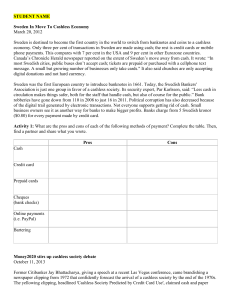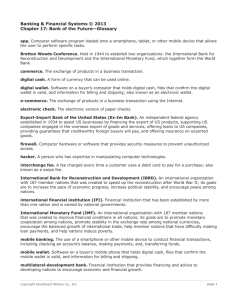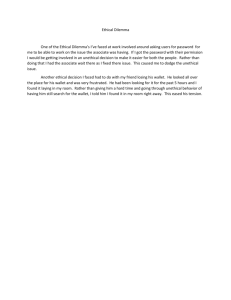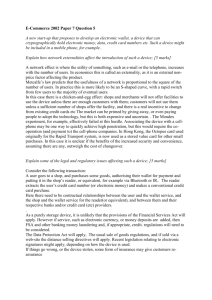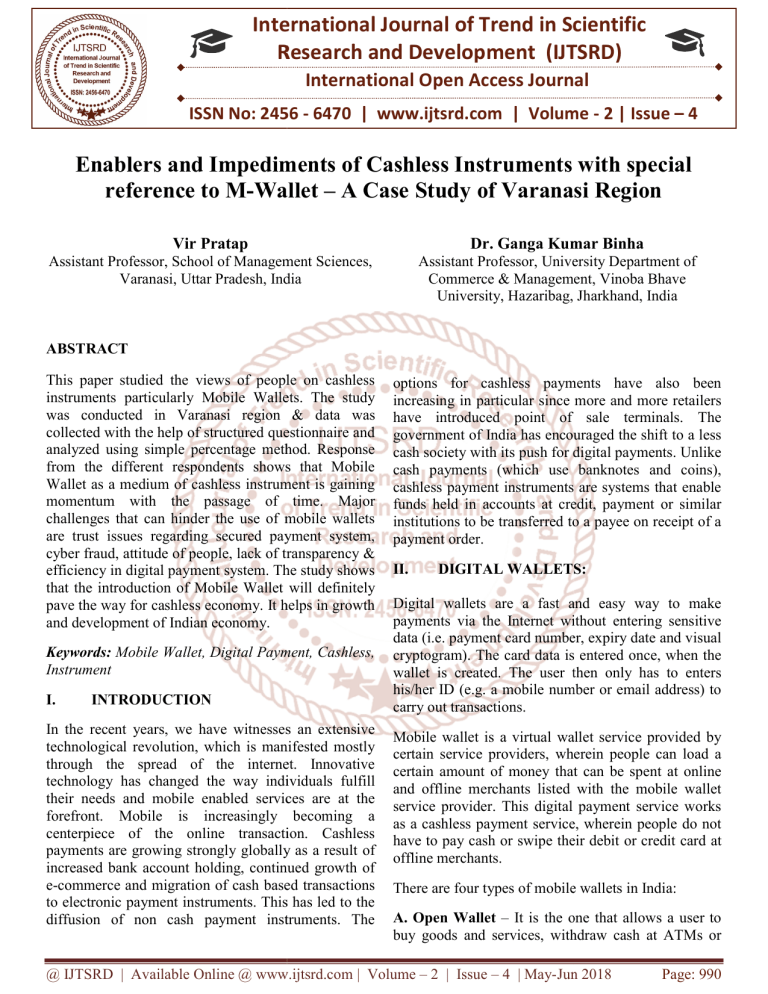
International Journal of Trend in Scientific
Research and Development (IJTSRD)
International Open Access Journal
ISSN No: 2456 - 6470 | www.ijtsrd.com | Volume - 2 | Issue – 4
Enablers and Impediments of Cashless Instruments with special
reference to M-Wallet
Wallet – A Case Study of Varanasi Region
Vir Pratap
Dr. Ganga Kumar Binha
Assistant Professor, School of Management Sciences,
Varanasi, Uttar Pradesh,, India
Assistant Professor, University Department of
Commerce & Management, Vinoba Bhave
University, Hazaribag, Jharkhand,
Jharkhand India
ABSTRACT
This paper studied the views of people on cashless
instruments particularly Mobile Wallets. The study
was conducted in Varanasi region & data was
collected with the help of structured questionnaire and
analyzed using simple percentage method. Response
from the different respondents shows that Mobile
Wallet as a medium of cashless instrument is gaining
momentum with the passage of time. Maj
Major
challenges that can hinder the use of mobile wallets
are trust issues regarding secured payment system,
cyber fraud, attitude of people, lack of transparency &
efficiency in digital payment system. The study shows
that the introduction of Mobile Wallet will definitely
pave the way for cashless economy. It helps in growth
and development of Indian economy.
Keywords: Mobile Wallet, Digital Payment, Cashless,
Instrument
I.
INTRODUCTION
In the recent years, we have witnesses an extensive
technological revolution, which is manifested mostly
through the spread of the internet. Innovative
technology has changed the way individuals fulfill
their needs and mobile enabled services are at the
forefront.
refront. Mobile is increasingly becoming a
centerpiece of the online transaction. Cashless
payments are growing strongly globally as a result of
increased bank account holding, continued growth of
e-commerce
commerce and migration of cash based transactions
to electronic
tronic payment instruments. This has led to the
diffusion of non cash payment instruments. The
options for cashless payments have also been
increasing in particular since more and more retailers
have introduced point of sale terminals. The
government of India has encouraged the shift to a less
cash society with its push for digital payments. Unlike
cash payments (which use banknotes and coins),
cashless payment instruments are systems that enable
funds held in accounts at credit, payment or similar
institutions
utions to be transferred to a payee on receipt of a
payment order.
II.
DIGITAL WALLETS:
Digital wallets are a fast and easy way to make
payments via the Internet without entering sensitive
data (i.e. payment card number, expiry date and visual
cryptogram). The
he card data is entered once, when the
wallet is created. The user then only has to enters
his/her ID (e.g. a mobile number or email address) to
carry out transactions.
Mobile wallet is a virtual wallet service provided by
certain service providers, wherein people can load a
certain amount of money that can be spent at online
and offline merchants listed with the mobile wallet
service provider. This digital payment service works
as a cashless payment service, wherein people do not
have to pay cash or swipe their debit or credit card at
offline merchants.
There are four types of mobile wallets in India:
A. Open Wallet – It is the one that allows a user to
buy goods and services, withdraw cash at ATMs or
@ IJTSRD | Available Online @ www.ijtsrd.com | Volume – 2 | Issue – 4 | May-Jun
Jun 2018
Page: 990
International Journal of Trend in Scientific Research and Development (IJTSRD) ISSN: 2456-6470
banks, and transfer funds. These services can only be
jointly launched with a bank. Additionally, it allows
its users to send money to any mobile number bank
account. Example: M-Pesa by Vodafone and ICICI
B. Semi-open Wallet – It is the one that allows its
users to transact with merchants that have a contract
with the semi wallet company. A user cannot
withdraw cash or get it back; he will have to spend the
amount he had loaded. Example: Airtel Money
E. Working of M-wallet
Smart phone users can install m-wallet
application on their mobile phones
M-wallet owners can creates his/her log in
account
They would receive a permanent pin
number for utilizing m-wallet services
Options available from the services include
money to banks, money to friends,
merchant payment, recharge and bill
payment
A bank account holder can load his/her mwallet through net banking, debit card,
credit card or cash
A non-bank account holder can load
his/her m-wallet with cash by visiting any
m-wallet retail store
Cash is loaded in the wallet; the person can
make payments through his mobile phone
C. Closed Wallet - It is quite popular with ecommerce companies. Here, a certain amount of
money is locked with the merchant in case of a
cancellation or return of the order, or gift cards.
Example: Flipkart e-wallet
D. Semi-Closed Wallet - It does not permit cash
withdrawal or redemption, but allows users to buy
goods and services at the listed merchants. Example:
Paytm
III.
REVIEW OF LITERATURE:
Review of literature paves way for a clear
understanding of the areas of research already
undertaken and throws a light on the potential areas
which are yet to be covered. Keeping this view in
mind, an attempt has been made to make a brief
survey of the work undertaken in the field of Cashless
Instruments. The reviews of some of the important
studies are presented below:
Jain, P.M (2006) in the article “E-payments and ebanking” opined that e- payments will be able to
check black,”An Analysis of Growth Pattern of
Cashless Transaction System. Taking fullest
advantage of technology, quick payments and
remittances will ensure optimal use of available funds
for banks, financial institutions, business houses and
common citizen of India. He also pointed out the need
for e-payments and modes of e-payments and
communication networks.
Nitika Rai and others (2012) in their study - “M
Wallet: A SMS based payment system”, mainly
emphasizes on, Wallet is an innovation that clearly
dominates its money transfer predecessors on virtually
all dimensions. It has been designed in adherence to
all the guidelines laid down by the RBI. M-Wallet
will allow people to use financial services in a more
efficient way and sometimes the only way - at more
affordable costs, and can greatly improve standards of
living. In developed markets, M-Wallet will be more
of an extension of the existing payment infrastructure
that allows people to deal with their financial needs in
a timely and convenient way.
ManpreetKaur
(2017)
in
her
study“Demonetization: Impact on Cashless Payment
System”, The cashless transaction system is reaching
its growth day by day , as soon as the market become
globalised and the growth of banking sector more and
more the people moves from cash to cashless system.
@ IJTSRD | Available Online @ www.ijtsrd.com | Volume – 2 | Issue – 4 | May-Jun 2018
Page: 991
International Journal of Trend in Scientific Research and Development (IJTSRD) ISSN: 2456-6470
The cashless system is not only requirement but also a
need of today society. All the online market basically
depends on cashless transaction system. The cashless
transition is not only safer than the cash transaction
but is less time consuming and not a trouble of
carrying and trouble of wear and tear like paper
money. It also helps in record of the all the transaction
done.
IV. Objectives
To study the enablers and impediments of cashless
instruments
To highlight the pros and cons of M-Wallet as
cashless instrument
V.
IV.
RESEARCH METHODOLOGY:
The study is conducted to obtain data on Enablers and
Impediments of Cashless Instruments particularly MWallet. The study is conducted in Varanasi region. A
sample size of 100 was selected using the
convenience sampling procedure out of which 89
copies were retrieved in usable form. This represents
a response rate of 89%. The sample includes only
educated population*, since they are the ones who
give their views on cashless instruments and use of
digital payment methods, there responses determine
the reliability of survey. Survey method is used for
collecting data with the help of questionnaire. The
responses from the respondents were collected and
analyzed using the simple percentage method.
ANALYSIS & INTERPRETATION:
Table I. Awareness
Questions
1) Have you made (online)
payment by smart phone.
2) Are you aware regarding
the functionality of MWallet?
3) Where did you get
information
about
MWallet?
4) Do you use M-Wallet for
financial transaction?
5) Why do you prefer MWallet over other modes of
payment?
6) Which M-Wallet do you
prefer most of the time?
Options
Yes
No
Yes
No
Frequency
90
10
87
13
Percentage
90
10
87
14
Social Media
Friends
Magazine
Television
Yes
No
Time saving
Ease of Use
Security
Offers
Paytm
Free charge
Mobikwik
Google wallet
28
19
5
35
63
37
13
10
0
40
33
19
9
2
32.18
21.83
5.74
40.22
63
37
20.63
15.87
0
45.97
52.38
20.15
14.28
3.17
Above table shows that about 90% of the respondent have made online payment through smart phone. Most of
respondent are aware about the mobile wallet. Television advertisement and social media plays the crucial role
followed by friends and magazine. Most of the respondent use mobile wallet i.e. 40%, due to its offers. Most
preferred mobile wallet company is Paytm, followed by Free charge and Mobikwik.
@ IJTSRD | Available Online @ www.ijtsrd.com | Volume – 2 | Issue – 4 | May-Jun 2018
Page: 992
International Journal of Trend in Scientific Research and Development (IJTSRD) ISSN: 2456-6470
Table II. Enablers
Questions
Options
1) What are your purposes Money transfer
of using M-Wallet?
Recharge
Utility & Bills
AOTA
2)What you keep in mind Available discount
when you use M-Wallet
Premium offers
Cash back
Ease of use
3) How often do you use Daily
M-Wallet?
Weekly
Monthly
4) How much money do Upto 20000
you load in M-Wallet on a Upto 15000
monthly basis?
Upto 10000
Upto 5000
5) How do you rate the Highly satisfactory
M-Wallet service that you Satisfactory
have used?
Neutral
Unsatisfactory
6) Would you want to Very likely
continue using M-Wallet? Likely
Neutral
Unlikely
Frequency
Percentage
7
19
13
24
27
24
9
3
3
19
41
3
7
17
36
17
31
10
5
23
32
8
0
11.11
30.15
20.63
38.09
42.85
38.09
14.28
4.76
4.76
30.15
65.07
4.76
11.11
26.98
57.14
26.98
49.20
15.87
7.93
36.50
50.79
12.69
0
Above table shows the major enabler of M-Wallet as cashless instruments, about 30% of respondent uses
mobile wallet for recharge purpose, followed by utility and bill payment, whereas 38% of the respondent uses
the M-Wallet to avail all the services. Discount is the main driving force among the users, followed by offers
and cash back reward. About 65% of respondent acknowledge that they use M-Wallet services on monthly
basis. 57% respondent load uptoRs. 5000, in M-Wallet and only around 5% of respondent load uptoRs. 20000.
49% respondents are satisfied and around 27% respondents are highly satisfied with the M-Wallet service.
Table III. Impediments
Questions
1) What are the obstacles
you face while using MWallet?
Options
Security of mobile
payment
Too
much
time
consuming
Risk of losing money
Not accepted widely
2) Are M-Wallet services Strongly agree
useful
modes
of Agree
Payment?
Neutral
Disagree
3) Do you believe your Strongly agree
Frequency
28
Percentage
44.44
9
14.28
19
7
29
23
8
3
30.15
11.11
46.03
36.50
12.69
4.76
11
17.46
@ IJTSRD | Available Online @ www.ijtsrd.com | Volume – 2 | Issue – 4 | May-Jun 2018
Page: 993
International Journal of Trend in Scientific Research and Development (IJTSRD) ISSN: 2456-6470
transactions are secured?
Agree
Neutral
Disagree
4) Would you like to Very likely
refer your friend to use Likely
M-Wallet?
Neutral
Unlikely
31
11
10
21
27
11
4
49.20
17.46
15.87
33.33
42.85
17.46
6.34
Above table shows the impediments of the M-Wallet service. Security of mobile payment and risk of loosing
money is the major hurdle in the wallet service. Still significant percentage of respondent are concerned about
the transaction security.
VI.
FINDINGS AND CONCLUSIONS:
From the above analysis we can say that Mobile
Wallet is gaining acceptance as one of the vital
cashless instruments among people. With increase in
smart phone, mobile wallet application is getting more
popular, even though majority of respondents are
concerned about the security of digital payment
system. Discount and offers are two major enablers of
mobile wallet. Service providers must create
awareness and trust among the users tobuild-up the
confidence level.
REFERENCES:
1. Bonsoni.com. 2011. Research shows mobile
phone payment double by 2013. [ONLINE]
Available
at:
http://www.bonsoni.com/blog/research-showsmobile-phone-payment-double-by-2013/.
[Accessed 01 August, 2017].
3. Rai, N., Ashok, A., Chakraborty, J., Arolker, P.,
&Gajera, S. (2012). M-Wallet: An SMS Based
Banking System. International Journal of
Engineering Research and Applications, 2(1), 1st
ser., 15-20.
4. Sultana, M. S., Dr, & Kumar, K. S. (2015). A
Study on Customer Payment Behavior in
Organized Retail Outlets at Coimbatore District.
Journal of Management and Science, 5(2), 1-16.
5. ASSOCHAM, India. (2016). M-Wallet: Scenario
Post
Demonetisation.
Retrieved
from
http://www.assocham.org/upload/docs/MWallet_Report_press.pdf.
6. Garg, P. (2017). Study on Introduction of Cashless
Economy in India 2016: Benefits & Challenge’s.
IOSR Journal of Business and Management,
19(4), ii, 116-120. doi: 10.9790/487X190402116120
2. National Payments Corporation of India. 2011.
Interbank Mobile Payment Service. [ONLINE]
Available
at:
http://www.npci.org.in/aboutimps.aspx. [Accessed
01August, 2017].
@ IJTSRD | Available Online @ www.ijtsrd.com | Volume – 2 | Issue – 4 | May-Jun 2018
Page: 994


